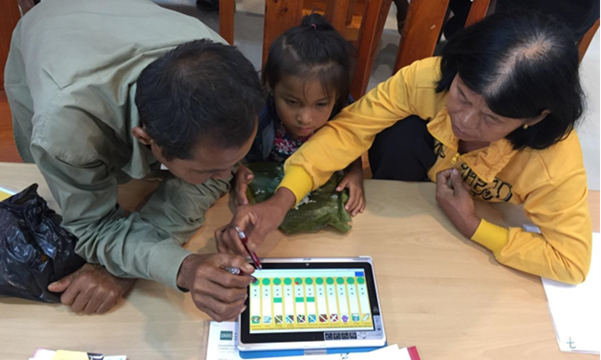
Despite the continuous introduction of new rice varieties, farmers persist in cultivating old and popular varieties susceptible to pests and diseases. Data from Investment Game Application (IGA) experiments and the Global Market Intelligence Platform (GloMIP) provide insights on farmers’ trait priorities that can help design target product profiles (TPPs) that support breeding programs and investment decisions.
The CGIAR Initiative on Market Intelligence gathers market intelligence by collecting data to map global and regional impact challenges across CGIAR’s five impact areas, translating them into subregional seed product market segments (SPMSs) and priorities for genetic innovation. By integrating several data sources—(1) IGA experiments, which empowered farmers in Southern Asia and South-eastern Asia to design their future varieties, (2) the current rice SPMS Database published in GloMIP (2023), (3) geospatial information, (4) TPP trait information, and (5) consultation with International Rice Research Institute (IRRI) rice breeders—key insights unveiled the farmers’ trait priorities in four irrigated rice SPMSs(1) Rice 4 SA for Jessore, Bangladesh, (2) Rice 16 SA for Rangpur, Bangladesh, and West Bengal and Odisha, India, (3) Rice 13 SEA for Prey Veng and Takeo, Cambodia, and (4) Rice 2 SEA for Nueva Ecija, Philippines (Table 1 ).
Table 1. Rice SPMSs and sampling for IGA experiments
| SPMSsa,b | Rice 4 SA (TEMS-I) |
Rice 16 SA (TLaMF-I) |
Rice 13 SEA (DELS-I) |
Rice 2 SEA (TMeLS-I) |
|
| Subregion | Southern Asia | ✔ | ✔ | ||
| South-eastern Asia | ✔ | ✔ | |||
| Production System | Transplanted (T) | ✔ | ✔ | ✔ | |
| Direct seeded (D) | ✔ | ||||
| Irrigated (I) | ✔ | ✔ | ✔ | ✔ | |
| Maturity | Early (E) | ✔ | ✔ | ||
| Medium (Me) | ✔ | ||||
| Late (La) | ✔ | ||||
| End-use (Grain Quality) | Long slender (L) | ✔ | ✔ | ||
| Medium length (M) | ✔ | ✔ | |||
| Soft texture (S) | ✔ | ✔ | ✔ | ||
| Firm texture (F) | ✔ | ||||
| Production Environment | Lowland | ✔ | ✔ | ✔ | ✔ |
| >IGA experiment study sites | Jessore, Bangladesh | Rangpur, Bangladesh and West Bengal and Odisha, India | Prey Veng and Takeo, Cambodia | Nueva Ecija, Philippines | |
| No. of farmers (N) | 160 | 482 | 312 | 244 | |
aThe short names are derived from the first letters of the SPMS identification criteria, e.g., TEMS-I refers to transplanted, early, medium soft, irrigated (IRRI 2021; CGIAR 2023).
bBased on the identification criteria for SPMS as outlined in Donovan et. al. (2022).
Unveiling trait priorities from each rice SPMS
Although the general emphasis of farmers is the need to prioritize biotic stress resistance, priority traits differ in each SPMS. In Rice 16 SA (Rangpur, Bangladesh, West Bengal, and Odisha, India) located in the Swarna Belt, the priorities revolved around improving biotic stress and lodging tolerance, emphasizing investments in improving Swarna’s resistance to bacterial leaf blight and resilience to flooding.
Grain quality traits are the top varietal traits in Rice 13 SEA (Prey Veng and Takeo, Cambodia) and Rice 4 SA (Jessore, Bangladesh). This may be attributed to increasing the market value of top replacement varieties such as Phka Rumdoul (a long-grain, jasmine-type variety), IR504 (a high-yielding, low stickiness variety), and BRRI dhan49 (medium bold variety).
A diverse portfolio of trait improvements was observed in Rice 2 SEA (Nueva Ecija, Philippines) that showcases a focus on loss reduction traits such as abiotic stress tolerance, lodging tolerance, and reduction to shattering for NSIC RC 222 to mitigate the adverse effect of typhoons.
Harnessing insights from corroborated data
Farmers’ trait priorities and the target product profiles (TPPs) in breeding pipelines indicate a substantial agreement. Essential traits in TPPs are demanded by farmers, such as insect resistance (i.e., to stem borer and brown plant hopper) and disease resistance (i.e., sheath rot and blast), which is consistent across all four SPMS. What appears to be missing in the current TPPs is resistance to tungro, which is known to be a recurring problem in South-eastern Asia and increasing in Bangladesh, putting India at risk. Effective tungro resistance trait genes are available, but their use appears limited. Abiotic stress tolerance was strongly emphasized in all four TPPs but was revealed to be a secondary priority for farmers compared with biotic stress resistance.
Through our Initiative on Market Intelligence work, we can identify stakeholders’ trait priorities and gaps with the current TPPs, which will provide important insights that may be used in strategic decisions that align with the needs of stakeholders, including farmers and breeders. This, in turn, helps with the design of the TPP, maximizes the impacts of breeding pipelines, and potentially accelerates varietal turnover in farmers’ fields.